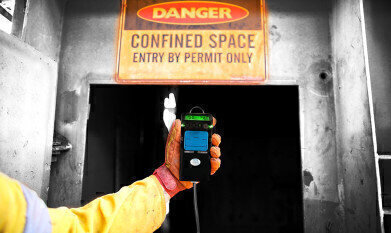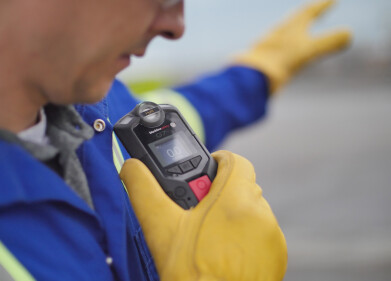Personal gas monitor
Minimizing confined space gas hazards
Nov 15 2022
Confined spaces (CS) are places that never or rarely need to be entered by people to perform required work. The first place that usually comes to mind with this is the entrance to a sewer or manhole. Less obvious confined spaces include tanks, stairwells, pits, or even just poorly ventilated higher areas in buildings.
What makes confined spaces so dangerous?
In addition to poor vision and restricted movement, atmospheric hazards are the most common danger in confined spaces.
Depending on the location of the confined space, various toxic or flammable gases or vapors may be present within and in close proximity. Many of these are colorless and odorless, making them barely or not at all noticeable.
Oxygen displacement, which can lead to asphyxiation, is also particularly common. Less common, but also dangerous, is too much oxygen in the air.
What to do when a confined space has to be entered
How can you minimize the risks these unknown hazards pose, before entering a confined space, even for short work assignments?
Hazardous areas like these should never be entered for sampling by only one person. This is a job for two, and it must be done conscientiously.
Preparation and equipment are critical
GfG’s multi-gas detectors are just as important for these tasks as the protection provided by a second person (buddy system) and personal protective equipment (PPE). Depending on the sensor configuration, our modern gas detectors can monitor up to eight gases simultaneously. This is a decisive advantage, if you do not know which gases to expect.
The first essential thing to do is to analyze the entrance area of the confined space. For spaces beneath the ground, we recommend the Polytector III G999 with integrated pump and connected test hose.
Alternatively, a Microtector III G888 can be lowered into the space on a cord. Our portable gas detection devices feature a PEAK function, that was designed specifically for this purpose. It displays the most recent peak values of the monitored gases for the duration of its activation.
For confined spaces at ground level or higher up, a telescopic suction lance can be attached to the G999.
It is essential that everyone entering the confined space carries a personal gas detection device, such as the compact G888, too.
You are only safe while you measure
Securing the entrance area of a confined space does not end there though. It must be monitored the entire time people are working in the area, as dangerous gases can enter the confined space after the first measurement.
The long battery life of the gas detection device G999 ensures continuous operation of the motorized pump even during long-term confined space analyzing. The G999 is also available without a pump, but with twice the battery life, for extended use as a personal gas detection device.
Learn more about our products and contact one of our experts today.
Digital Edition
PIN 25.6 Buyers' Guide
January 2025
Buyers' Guide Directory - Product Listings by Category - Suppliers Listings (A-Z) Articles Analytical Instrumentation - ASTM D7042: The Quantum Leap in Viscosity Testing Technology -...
View all digital editions
Events
Feb 25 2025 London. UK
SPS Smart Production Solutions Guangzhou
Feb 25 2025 Guanghzou, China
Feb 27 2025 Kathmandu, Nepal
Mar 01 2025 Boston, MA, USA
Mar 02 2025 Bethesda, MD, USA
























